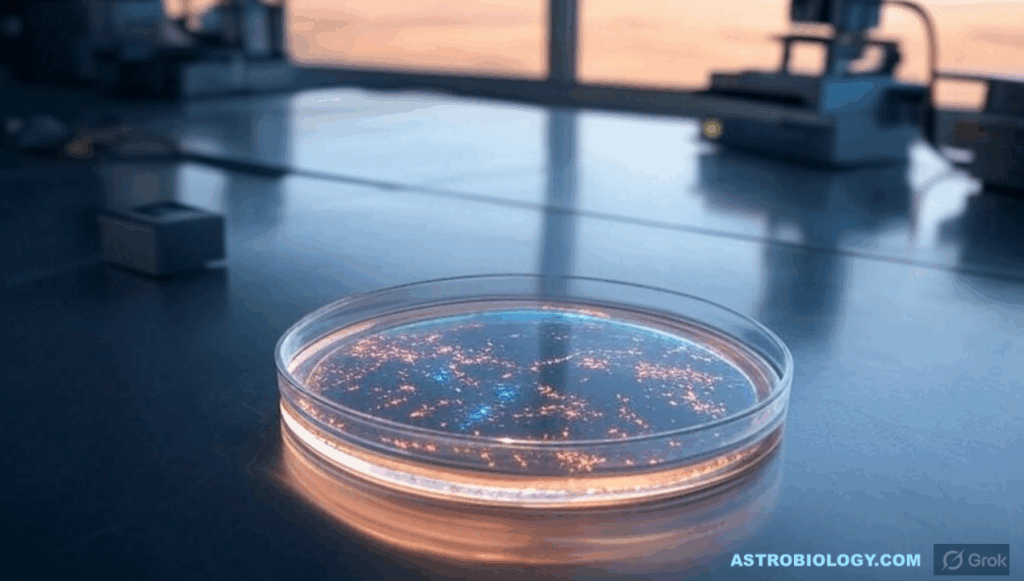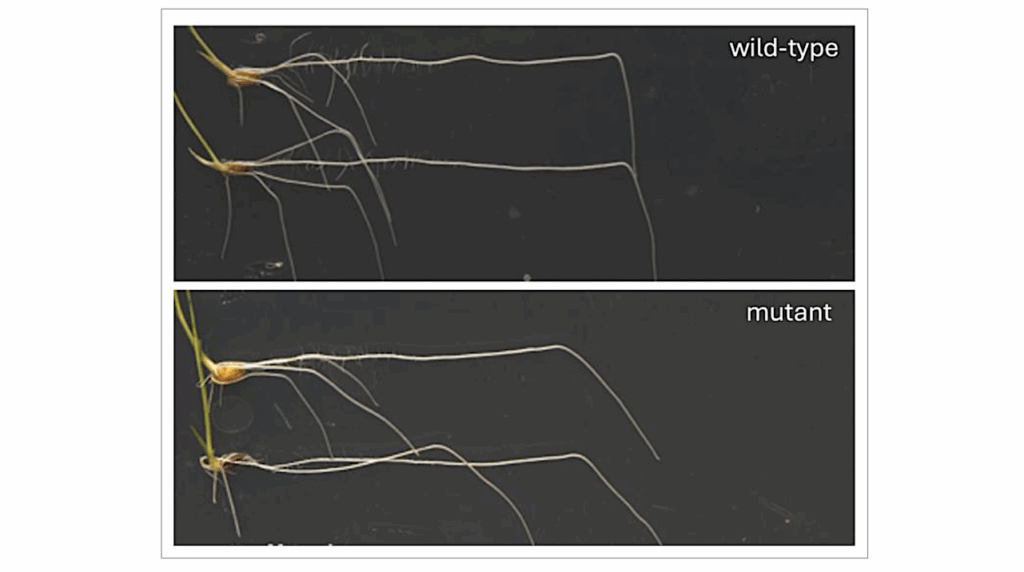NASA Spaceline Current Awareness List #1,169 10 October 2025 (Space Life Science Research Results)

space life science – Grok via astrobiology.com
The abstract in PubMed or at the publisher’s site is linked when available and will open in a new window.
Papers deriving from NASA support:
- Clément G, Moudy S, Macaulay TR, Wood SJ.Effects of short-duration spaceflight on the execution of critical mission tasks.Front Physiol. 2025 Sep 29;16:1677377.Note: ISS results. From the article: “Two groups of participants took part in this study. The first group, referred to as the short-duration group, consisted of 10 healthy individuals (6 males, 4 females; mean age = 45.9 years, standard deviation [SD] = 13.3 years) who completed an Axiom, Fram2, or Soyuz taxi mission lasting from 4 to 21 days (mean = 10.4 days, SD = 7.4 days). Eight of these individuals were first-time flyers; whereas, the other 2 individuals had previously completed multiple 6-month missions in space. The second group, referred to as the long-duration group, included 36 healthy individuals (22 males, 14 females; mean age = 47.7 years, SD = 8.5 years) who completed an ISS mission lasting from 5 to 12 months (mean = 6.8 months, SD = 1.7 months) aboard the ISS.” This article may be obtained online without charge.
Journal Impact Factor: 3.4
Funding: “Funding was provided by the National Aeronautics and Space Administration (NASA). The data report here were from the NASA Human Research Program Standard Measures Cross-Cutting Project.”” - Lee R, Rayhun A, Kim JK, Meydan C, Beheshti A, Sporn K, Kumar R, Calixte J, McNerney MW, Shah J, Waisberg E, Ong J, Mason C.Genomic analysis of cardiovascular diseases utilizing space omics and medical atlas.Genes (Basel). 2025 Aug 25;16(9):996.PI: C. MasonNote: This article appeared in last week’s list in the “Other” section. It is appearing in this list along with the NASA funding information. This article is part of Section “Molecular Genetics and Genomics” (https://www.mdpi.com/journal/genes/sections/molecular_genetics) and may be obtained online without charge.
Journal Impact Factor: 2.8
Funding: PI reports NASA CHIP grant funding. - Mozneb M, Arzt M, Moses J, Escopete S, Wiegand L, Sharma A.Stem cell research in space: Advancing regenerative medicine beyond Earth.Cell Stem Cell. 2025 Oct 2;32(10):1491-508. Review.Note: This article may be obtained online without charge.
Journal Impact Factor: 20.4
Funding: “A.S. is supported by the Board of Governors Regenerative Medicine Institute at Cedars-Sinai, an In-Space Production Award (InSPA) from NASA, an Igniting Innovation Award from the International Space Station National Laboratory (ISSNL), and a California Institute for Regenerative Medicine (CIRM) Infrastructure Award.” - Koirala S, Perdomo B, Billings B, Welch D, Vijayakumar R, Nelli M, Moore C, Phillips C, Burns IH, Mitra K.Impact of simulated microgravity environment on bioprinted tissue constructs.Gravit Space Res. 2025 Sep;13(1):65-74.Note: A random position machine was used in this study. This article may be obtained online without charge.
Journal Impact Factor: 0.2
Funding: “The authors would like to acknowledge the Microgravity Simulation Support Facility at NASA Kennedy Space Center for providing the access of RPM.” - Vitry G, Angdisen J, Sawant MA, Arriaga P, Irgen-Gioro S, Peshette P, Vuong DC, Ilhardt P, Fehr J, Cwikla B, Ponnaiya B, Inman JL, Snijders AM, Hamid S, Caballero-Lima D, Garty G, Apfeldorf K, Laiakis EC.Using a full thickness bioengineered human skin equivalent as a model for radiation biology research.Sci Rep. 2025 Oct 6;15(1):34702.Note: This article may be obtained online without charge.
Journal Impact Factor: 3.9
Funding: P. Ilhardt is affiliated with NASA Johnson Space Center. - Sanford LD, Adkins AM, Boden AF, Luyo ZZNM, Singh N, Britten RA, Wellman LL.Effects of social isolation alone and combined with 15cGy GCRsim space radiation on fear conditioned behavioral, stress, and sleep responses.Life Sci Space Res. 2025 Oct 2. Online ahead of print.PI: L.D. SanfordNote: This article may be obtained online without charge.
Journal Impact Factor: 2.8
Funding: “NASA CBS VNSCOR grant 80NSSC19K1582.” - Wu Z, Hsu SK, Opdensteinen P, Steinmetz NF.A plant virus supramolecular NanoSponge for delivery of agricultural pesticides to the rhizosphere.ACS Appl. Mater. Interfaces. 2025 Sep 23.PI: P. OpdensteinenJournal Impact Factor: 8.2
Funding: “The chemical synthesis and material characterization work was supported by the NSF Center for the Chemistry of Molecularly Optimized Networks (MONET), CHE-2116298. The testbed studies with applications in agriculture were supported through NIFA-2020-67021-31255. P.O. was supported in part through a TRISH postdoctoral fellowship by the Translational Research Institute for Space Health (TRISH) through the NASA Cooperative Agreement NNX16AO69A.” - Mettler MK, Peyton BM.Multimodal biofilm control strategies for spacecraft water systems: Evaluating coatings, nutrient removal, and biocides for improved sustainability.Gravit Space Res. 2025 Sep;13(1):75-89.Note: This article may be obtained online without charge.
Journal Impact Factor: 0.2
Funding: “Funding was provided by NASA through the EPSCoR cooperative agreement 80NSSC21M0331.”
Other papers of interest:
- Arbeille P, Zuj K, Greaves D, Hughson R.Carotid wall structure during and after 6 months of spaceflight.Front Physiol. 2025 Oct 8;16:1638531.Note: ISS results. This article may be obtained online without charge.
- Diaz TE, Sullivan RD, Ashworth ET, Buesking SC, Haggarty AM, Carmichael BDM, Singh G.Magnesium alterations in human spaceflight.Aerosp Med Hum Perform. 2025 Oct 1;96(10):919-30. Review.
- Hao J, Chang J, Deng Y.Spaceflight and ground-based microgravity simulation impact on cognition and brain plasticity.Int J Mol Sci. 2025 Sep 29;26(19):9521. Review.Note: This article is part of Section “Molecular Neurobiology” (https://www.mdpi.com/journal/ijms/sections/Molecular_Neurobiology) and may be obtained online without charge.
- Henke J, Kamboj S, Barrett D, Idris H, Gangal A, Blalock T.Therapeutic and diagnostic perspectives for advancing spaceflight dermatologyAerosp Med Hum Perform. 2025 Oct 1;96(10):947-9.Note: This article is a Commentary.
- Yang E, Dhanaraj JJ, Tharushi Perera PG, Vilagosh Z, Iles GN, Krämer S, Florin G, Linklater DP, Nguyen THP, Dekiwadia C, Juodkazis S, Croft RJ, Ivanova EP.Effects of extreme acceleration, microgravity, and deceleration on Bacillus subtilis onboard a suborbital spaceflight.npj Microgravity. 2025 Oct 6;11:65.Note: This article is a Brief Communication and may be obtained online without charge.
- Campbell MR.History of the assured crew return vehicle and spaceflight medical evacuation.Aerosp Med Hum Perform. 2025 Oct 1;96(10):953-5.
- Gonzalez Viejo C, Mayorga-Martínez AA, Harris N, Villarreal-Lara R, Fuentes S.Spaceward senses: Examining retronasal aroma and mouthfeel perception in simulated space-microgravity environments.npj Sci Food. 2025 Oct 3;9:202.Note: This article may be obtained online without charge.
- Liang R, Fang T, Wang L, Ren J, Meng L, Zhao M, Zheng C, Fan Q, Chen Y, Yang J, Ming D.Multi-connectomics underpin emotional dysfunction in mouse exposed to simulated space composite environmentTransl Psychiatry. 2025 Oct 6;15:359.Note: This article may be obtained online without charge.
- Naito M, Kodaira S.Charge-weighted quality factors based on LET for practical dose assessment of space radiation.Life Sci Space Res. 2025 Oct 9. Online ahead of print.
- Pelchat M, Trudel G, Rocheleau L, Stratis D, Laneuville O.Microgravity-induced immune dysregulation: Phase-specific profiles of differential gene expression.Biochem Cell Biol. 2025 Oct 8;103:1-12.Note: Head-down tilt bedrest study. This article may be obtained online without charge.
- Krämer CL, Müller DW, Arndt F, Rehm A, Walkenfort B, Ahmed AS, Haben A, Schiele A, Auerhammer A, Hasenberg M, Boschert AL, Kautenburger R, Leuko S, Janssen S, Maurer M, Mücklich F, Siems K.Touching surfaces – Presence of microorganisms on antimicrobial metal surfaces on the International Space Station and in German schools.BMC Microbiol. 2025 Oct 6;25:631.Note: This article may be obtained online without charge.
- Pham T-H, Bi J, Mesa-Arango R, Nguyen K-D.Predicting space tourism demand using explainable AI.Acta Astronaut. 2026 Jan;238:1225-37.Note: From the abstract: “This paper proposes an explainable and trustworthy artificial intelligence (AI) framework designed to address the challenge of predicting space tourism demand by adhering to the National Institute of Standards and Technology (NIST) guidelines.”
- Van Puyvelde M, van den Berg NH, Stas L, Savieri P, Corlùy H, Van Cutsem J, Neyt X, Simonelli G, Pattyn N.Beyond the lab coat: Methodological challenges in space life sciences.Front Physiol. 2025 Oct 3;16:1663701.Note: This article is part of Research Topic “Innovations in Tools and Methods for Life Sciences Research in Space” (https://www.frontiersin.org/research-topics/68978/innovations-in-tools-and-methods-for-life-sciences-research-in-space). The Research Topic also includes articles from previous Current Awareness Lists #1,155 https://doi.org/10.3389/fphys.2025.1599005, #1,156 https://doi.org/10.3389/fphys.2025.1622401, #1,165 https://doi.org/10.3389/fphys.2025.1628696, and #1,168 https://doi.org/10.3389/fphys.2025.1621099. This article may be obtained online without charge.
- Xue J, Wang M, Liu S, Xu C, Yu H, Guo Y, Han B.Osteoblast dysfunction associated with mitophagy suppression under simulated microgravity.Biomed Eng Online. 2025 Oct 6;24:113.Note: A rotary cell culture system was used in this study to simulate microgravity. This article may be obtained online without charge.
- Artamonov A.[Phenomenological model of the effects of electromagnetic fields on humans.]Aviakosm Ekolog Med. 2025;59(4):15-26. Russian.
- Sanchez BN, Soufi S, Saenz C, Kraemer WJ, Lee EC, Volek JS, Maresh CM.Exercise heat stress responses in unacclimatized endurance- and resistance-trained women.Aerosp Med Hum Perform. 2025 Oct 1;96(10):872-83.
- Stemper BD, Muftuler LT, Cutlan R, Strother C, Sherman KA, Meier TB, Raff H, Yoganandan N, Gerds B, Dooley C, Le P, Hainsworth KR, Vedantam A.Abnormal pattern of spondylosis and postflight neck flexibility in fifth-generation fighter pilots.Aerosp Med Hum Perform. 2025 Oct 1;96(10):884-93.
- Tomilovskaya ES, Riabova AM, Rukavishnikov IV, Shigueva TA, Bekreneva MP, Saveko AA, Kukoba TB, Fomina EV, Zelenskaya IS, Shishkin NV, Kitov VV, Amirova LE, Yarmanova EN.Axial loading as a countermeasure to hypogravitational disorders in sensory-motor system.Acta Astronaut. 2026 Jan;238:1238-
- Yang WYL, Chay IWJ, Lim HB, Tan MCL, See B, Low JW.Pachychoroid neovasculopathy, intravitreal injection, and implications for aeromedical decision making.Aerosp Med Hum Perform. 2025 Oct 1;96(10):940-6.
- Goncharova AA, Besedina NG, Danilenkova LV, Kamysheva EA, Bragina JV.[Effect of gender and stage of drosophila development during a stay aboard the ISS on the ability to adapt behavior to Earth’s gravity].Aviakosm Ekolog Med. 2025;59(4):47-55. Russian.
- Shafirkin AV, Mitrikas VG, Bondarenko VA.[Calculation of effective residual tissue average doses from scr doses to cosmonauts in long-duration missions aboard orbital stations MIR and ISS with consideration of reparation processes.]Aviakosm Ekolog Med. 2025;59(4):35-46. Russian.
- Supolkina NS, Yusupova AK, Shved DM, Nosovsky AM, Guschin VI.[Dynamics of communication within the crew-MCC loop in the process of long-term space mission.]Aviakosm Ekolog Med. 2025;59(4):27-34. Russian.
- Tekutskaya EE, Gusaruk LR, Pavliuchenko II, Ilchenko GP.[Structural changes of lymphocyte DNA due to exposure to non-ionizing microwave radiation in a medium with a modified isotope content.]Aviakosm Ekolog Med. 2025;59(4):74-82. Russian.
astrobiology, space biology, space medicine, microgravity, ISS,








